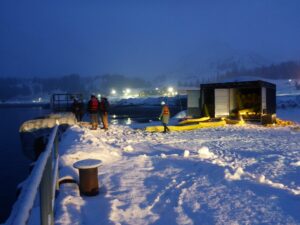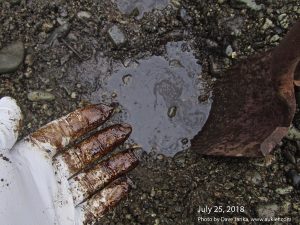
For the past few years, the COVID-19 pandemic affected many aspects of daily life. Oil spill drills and exercises were not exempt. Restrictions to protect the health and safety of responders limited these activities.
Not only were there fewer drills and exercises, they were harder to observe. Social distancing meant that Council staff could not board tugs and barges to see response operations up close. Council staff members Roy Robertson and Jeremy Robida, who have monitored drills and exercises in Prince William Sound for the past 18 and 13 years respectively, conducted some observations from a separate chartered vessel.
Fortunately, this year many of the restrictions were lifted.
New report summarizes 2022 drills
The Council’s annual report on drills and exercises conducted in Prince William Sound in 2022 has been released. The report highlights some of the continuing effects from the pandemic, along with a few changes that are here to stay.
Conducting business online
Virtual conferencing has changed many workplaces, including oil spill response. These technologies have shown up in several ways.
Coordinating online: Many drills are now hybrid (in person with online participants). Meetings are broadcast on videoconferencing platforms. Documents and other data are shared through online collaboration tools. Robertson says there are still some glitches, but these are improving.
Live video streaming: During a drill in May, the Alaska Department of Environmental Conservation deployed a drone over some activities out on the water. They were able to stream live video to the Valdez command center and participants in Jacksonville, Florida. The video was also recorded and available for later review.
Online training options: Alyeska’s Ship Escort Response Vessel System conducts annual trainings for crews of local fishing vessels, who are contracted to respond in case of a spill. Before the pandemic, part of the training sessions were held in a classroom, part were hands-on experience with equipment on dry land, and finally, crews would practice deploying equipment on the water.
Since the pandemic, the classroom sessions have been held online. The dry-land portion that required closer physical interaction between participants had not been held since 2020, but returned in 2023. The on-water portion remains the same.
Improvements at Valdez Duck Flats
Pandemic restrictions particularly affected exercises to practice either diverting oil from shorelines or protecting locations that are particularly sensitive to oil contamination, such as hatcheries. These tactics are performed by fishing vessels which have little room for social distancing. The return to in-person exercises is important for these activities.
Robertson noted in the report that responders spent more time this year practicing tactics to protect the Valdez Duck Flats, a highly productive biological area that provides critical habitat for a variety of waterfowl, small mammals, and marine mammals. This area is particularly sensitive to oil contamination. This was time well spent, he says. Robertson said that the responders have become more proficient at these tactics.
More details in the report: Drill Monitoring Annual Report for 2022
